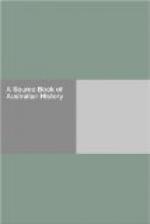July 1st. Descending the cliffs with difficulty, we followed along the foot of them, which was beautifully grassed, and, after travelling twelve miles, beheld the Eucla sand-hills. On my pointing them out, every heart was full of joy, and, being away some distance, I heard the long and continued hurrahs from the party! Eucla was all the conversation! I never before remember witnessing such joy as was evinced on this occasion by all the party. After travelling five miles further, we camped close to the cliffs at a small water-hole. We might have reached Eucla this evening, but I preferred doing so to-morrow, when we could have the day before us to choose camp. We are now again in safety, Eucla being only seven miles distant; after having travelled 166 miles without finding permanent water—in fact, over 300 miles with only one place where we procured permanent water. I trust we all recognized with sincerity and thankfulness the guiding and protecting Father who had brought us through in safety.
July 2nd. Made an early start and steered straight for the anchorage, distant about five miles, having first ascended the range to have a view of the country, which was very extensive. Far as the eye could reach to the westward, the Roe Plains and Hampton Range were visible; while to the eastward lay Wilson’s Bluff and the Delissier sand-hills; and three miles west of them we were delighted to behold the good schooner Adur, riding safely at anchor in Eucla harbour, which formed by no means the least pleasing feature of the scene to our little band of weary travellers. Made at once for the vessel, and on reaching her, found all well and glad to see us. She was anchored between the Red and Black Beacons. The latter had been blown down, but shall be re-erected. There being no water at the anchorage, moved on to the Delissier sand-hills, where we found water by digging two and a half feet from the surface. Camped on the west side of the sand-hills.
Landed barley, etc., from the boat. There was a good feed for the horses under the Hampton Range, about a mile and a half distant.
July 11th. Osborn busy with the shoeing. Went with Billy to Wilson’s Bluff, and saw the boundary-post between South and Western Australia, placed by Lieutenant Douglas.
July 12th. Erected the flagstaff with the Union Jack flying, and nailed a copperplate to the staff, with the following engraved on it:
WESTERN AUSTRALIA. ERECTED BY J. FORREST,
JULY 12TH, 1870.
July 17th. Was obliged to get up twice to bring back the horses, and at 4 o’clock made a start. The horses were in a very exhausted state; some having difficulty to keep up. About noon I could descry the land turning to the southward, and saw, with great pleasure, we were fast approaching the Head of the Great Australian Bight. Reached the sand-patches at the extreme head of the Bight just as the sun was




